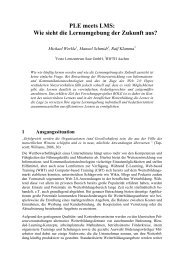Customized PLE implementations for test-bed scenario ... - ROLE
Customized PLE implementations for test-bed scenario ... - ROLE
Customized PLE implementations for test-bed scenario ... - ROLE
You also want an ePaper? Increase the reach of your titles
YUMPU automatically turns print PDFs into web optimized ePapers that Google loves.
ed has an organisational policy <strong>for</strong> which an agreement is obligatory. Practice sharing<br />
amongst learners is not fostered and done in<strong>for</strong>mally if at all.<br />
From the technical perspective of the <strong>ROLE</strong> vision, the OU <strong>test</strong>-<strong>bed</strong> does not support<br />
the theoretical (psycho-pedagogical and community) models through facilities <strong>for</strong><br />
creating or visualising them. On the other hand, communication and collaboration is<br />
supported by various tools like FlashMeeting, FlashVlog, learning journals (blogs),<br />
learning clubs (<strong>for</strong> users with common interests), and <strong>for</strong>ums. Furthermore,<br />
Compendium is suggested as a tool <strong>for</strong> creating learning path maps in order to<br />
sequence resources that remix content and activities from OpenLearn and other<br />
sources. Training materials <strong>for</strong> tools are authored in HTML (provided as Moodle<br />
courses). Participation in <strong>for</strong>ums is another way of providing support to learners.<br />
All learning services are either provided by the core Moodle installation or through plugins.<br />
An integrative <strong>PLE</strong> infrastructure does not exist. The <strong>test</strong>-<strong>bed</strong> allows the usage of<br />
desktop applications (e.g. Compendium) and provides server-sided plat<strong>for</strong>ms (e.g.<br />
Moodle or FlashMeeting) as well. However, it is not possible to combine the different<br />
technologies through UI mash-ups, linkage of data, system interoperability, or other<br />
mechanisms. Similarly, protocols and service designs <strong>for</strong> enabling interoperability and<br />
mash-ups are not used in the <strong>test</strong>-<strong>bed</strong>. Addressing data representation types and<br />
<strong>for</strong>mats, resources are descri<strong>bed</strong> with IEEE LOM and RDF/OWL and can be harvested<br />
according to the Open Archives Initiative Protocol <strong>for</strong> Metadata Harvesting (OAI-PMH).<br />
No other standards <strong>for</strong> structuring data and specifying architectures, interfaces, or<br />
communication between systems are utilised. User profiles are based on the Moodle<br />
functionality (standard profiles). Course content can be accessed without authentication.<br />
For an active participation in the courses users have to log in. This account can be used<br />
<strong>for</strong> other tools in the <strong>test</strong>-<strong>bed</strong> as well. Moreover, OpenLearn builds upon the creative<br />
commons license <strong>for</strong> digital rights management issues. Learner interactions are logged<br />
by OpenLearn but this data is only used <strong>for</strong> providing activity reports to learners. Due to<br />
privacy considerations, learners can restrict monitoring and choose what parts of their<br />
profiles are public and if they wish to be contacted <strong>for</strong> research purposes.<br />
A typical <strong>scenario</strong> in the <strong>test</strong>-<strong>bed</strong> is a sensemaking activity in which learners use<br />
Cohere (web-application) or Compendium (desktop tool) to describe strategies <strong>for</strong><br />
studying open educational resources (OER) or to create learning path maps.<br />
Furthermore, tools are used to communicate and collaborate within learning activities.<br />
From the development perspective, the OpenLearn technical team, comprised both<br />
academics and developers, observes the plat<strong>for</strong>m and tool usage, analyses user<br />
feedback from evaluations and decides on changes to the learning software<br />
accordingly. Feedback by users comprises new requirements as well as usability<br />
issues. New learning tools are added to OpenLearn from time to time. Requirements<br />
are quite loose; the new tool needs to be associated with learning. External<br />
stakeholders cannot bring in own ideas or technology into the <strong>test</strong>-<strong>bed</strong>. Finally, the <strong>test</strong><strong>bed</strong><br />
has already a repository of tools <strong>for</strong> learning. Access to these tools is provided in<br />
the OpenLearn plat<strong>for</strong>m (http://openlearn.open.ac.uk/course/category.php?id=14). The<br />
tools maintained by the OU are evaluated according to different criteria (utility, usability)<br />
and with state-of-the-art techniques (inspection and <strong>test</strong> methods, eye-tracking, etc).<br />
Page 26 of 102



